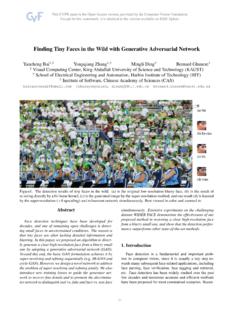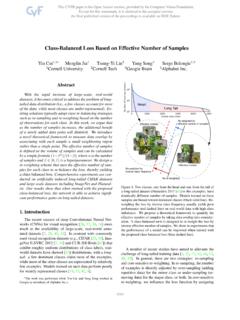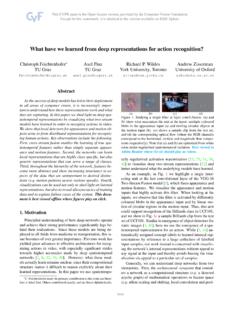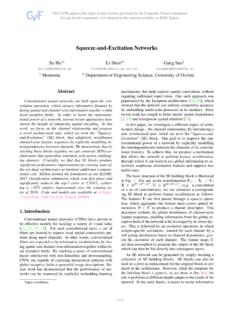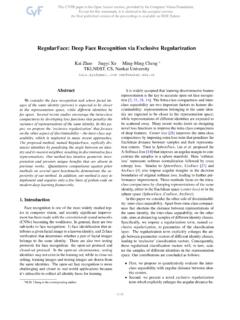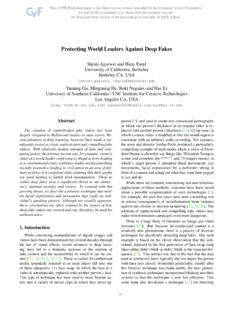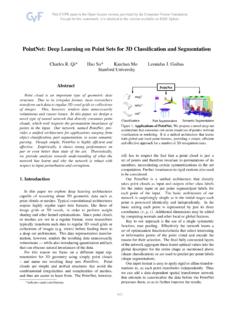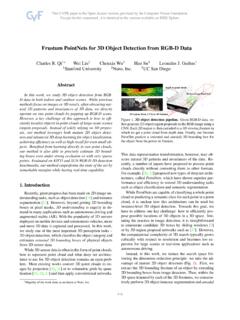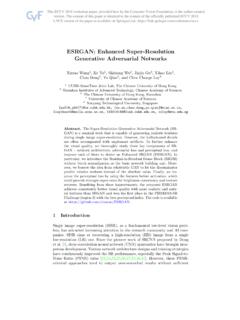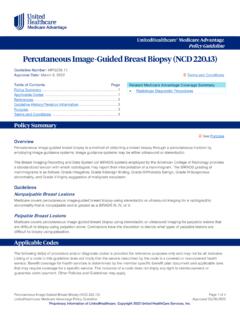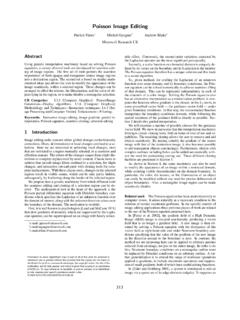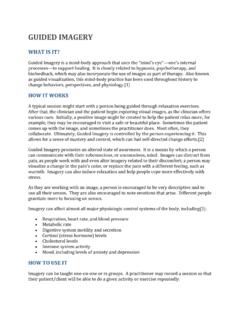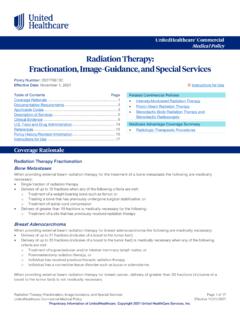Transcription of PSD: Principled Synthetic-to-Real Dehazing Guided by ...
1 PSD: Principled Synthetic-to-Real Dehazing Guided by Physical PriorsZeyuan Chen1, Yangchao Wang2, Yang Yang2, Dong Liu1*1 University of Science and Technology of China, Hefei, China2 University of Electronic Science and Technology of China, Chengdu, learning-based methods have achieved remarkableperformance for image Dehazing . However, previous studiesare mostly focused on training models with synthetic hazyimages, which incurs performance drop when the modelsare used for real-world hazy images. We propose a Prin-cipled Synthetic-to-Real Dehazing (PSD) framework to im-prove the generalization performance of Dehazing . Startingfrom a Dehazing model backbone that is pre-trained on syn-thetic data, PSD exploits real hazy images to fine-tune themodel in an unsupervised fashion.
2 For the fine-tuning, weleverage several well-grounded physical priors and com-bine them into a prior loss committee. PSD allows formost of the existing Dehazing models as its backbone, andthe combination of multiple physical priors boosts dehazingsignificantly. Through extensive experiments, we demon-strate that our PSD framework establishes the new state-of-the-art performance for real-world Dehazing , in terms ofvisual quality assessed by no-reference quality metrics aswell as subjective evaluation and downstream task perfor-mance IntroductionDue to the existence of haze, outdoor images often suf-fer from low contrast and limited visibility, which adverselyaffects the performance of subsequent high-level computervision tasks, such as object detection and recognition.
3 Thus,more and more attention is drawn to image Dehazing , thataims to recover the clean image from a hazy to the physical scattering model [24,27], thehazing process is usually formulated asI(x) =J(x)t(x) +A(1 t(x))(1)*This work was supported by the Natural Science Foundation of Chinaunder Grants 62022075 and 61931014. Our code and models are to- Real- Dehazing - Guided - by- Physical-Priors.(Corresponding author: Dong Liu.)(a) Hazy image (b) DAD [34](c) MSBDN [6](d) OursFigure 1. Dehazing results on a real hazy (x)is the observed hazy image ,J(x)is the sceneradiance to be (x)are the global atmo-spheric light and the transmission map, the clean image from a single hazy input is anill-posed problem.
4 Early methods [1,8,9,11,37] try to es-timate transmission map by physical priors and then restoreimage via the scattering model. However, these physicalpriors are not always reliable, leading to inaccurate trans-mission estimates and unsatisfied Dehazing the advances in deep learning, many methods basedon convolutional neural networks (CNNs) [3,4,7,14,22,31,32] have been proposed to overcome the drawbacks of us-ing physical priors. They are more efficient and outperformtraditional prior-based algorithms. In common cases, largequantities of paired hazy/clean images are necessary for thetraining of CNN-based Dehazing models. However, it is al-most impossible to obtain these image pairs from the realworld, and most learning-based methods resort to trainingon synthetic data.
5 Unfortunately, due to the domain gapbetween synthetic and real data, Dehazing models trainedon synthetic images usually generalize poorly to real-worldhazy , this issue has been picked up by a handful of7180studies. Liet al. [17] proposed a semi-supervised dehaz-ing model trained on both synthetic data and real-worldimages. Shaoet al. [34] suggested a domain adaptationframework to reduce the gap between synthetic and real do-mains. These methods demonstrate the great potential ofdomain adaptation in improving the performance for real-world Dehazing tasks. However, there is still room for fur-ther improvement, and Principled frameworks dedicated forthe problem of Dehazing generalization remain a this paper, we propose a Principled Synthetic-to-realDehazing (PSD) framework, which is applicable to general-ize most of the existing Dehazing models to the real includes two phases: supervised pre-training and unsu-pervised fine-tuning.
6 For pre-training, we modify a chosendehazing model backbone into a physics-based network andtrain this network with synthetic data. Taking advantage ofthe well-designed backbone, we could obtain a pre-trainedmodel with solid Dehazing performance on the syntheticdomain. For fine-tuning, we exploit real hazy images totrain the model in an unsupervised manner. We investigatethe strong physics background of Dehazing tasks and elab-orately select three physical priors to constitute a loss com-mittee that guides the unsupervised training. The key ideaof this fine-tuning process is the intuition that good dehaz-ing results shall share some common properties/statisticalpriors.
7 We leverage this intuition, treating the loss commit-tee as a task-specific proxy guidance to help generalize ourmodel to the real domain. As shown in , PSD producesa better Dehazing result when compared with the backbonemodel. PSD also outperforms the state-of-art domain adap-tation Dehazing (DAD) [34].We summarize the contributions of our work as follows. We re-formulate the real-world Dehazing task as asynthetic-to-real generalizationframework: startingfrom a Dehazing model backbone pre-trained on syn-thetic paired data, real hazy images will be subse-quently exploited to fine-tune the model in an unsu-pervised fashion. PSD is Principled , easy-to-use, andcan take most deep Dehazing models as its backbone1.
8 Due to the absence of clean ground-truth image as su-pervision, we leverage several popular, well-groundedphysical priors to guide the fine-tuning. We combinethem into aprior loss committeeas the task-specificproxy guidance, which constitutes the core of show that these priors are complementary and theircombination boosts PSD Dehazing the most. Our framework is compared with a number of com-petitive methods via comprehensive experiments. Re-sults are evaluated in terms of visual quality assessedby both no-reference quality metrics and subjective1 Some models are subject to light modifications, see , and downstream task performance indica-tor.
9 Consistently and substantially, PSD establishes thenew state-of-the-art real-world Dehazing Related Single image DehazingPrior-based methods based on pri-ors [1,8,9,11,37,43] estimate transmission maps by ex-ploiting statistical properties of clean images, and then ob-tain dehazed results using the scattering model. In [37],Tan proposed a haze removal method by maximizing thelocal contrast of hazy images. Heet al. [11] achieved im-pressive Dehazing results using dark channel prior (DCP),which assumes that there exists at least one channel for ev-ery pixel whose value is close to zero. Zhuet al. [43] pro-posed a color attenuation prior to remove haze by estimatingthe scene depth.
10 Fattal [9] introduced a color-line prior bythe observation that pixels of small image patches typicallyexhibit a one-dimensional distribution in RGB color al. [1] proposed a Dehazing algorithm based onthe assumption that colors of a haze-free image are wellapproximated by a few hundred distinct colors. Althoughthese methods have been shown effective for image dehaz-ing, their performances are usually limited because thesehand-crafted priors do not always hold for different the availability oflarge-scale paired data and powerful CNNs, learning-baseddehazing methods have become popular in recent [31] is one of the first studies to solve haze re-moval problem via CNN, where the network is trained to es-timate transmission map of the hazy input in a coarse-to-finemanner.
